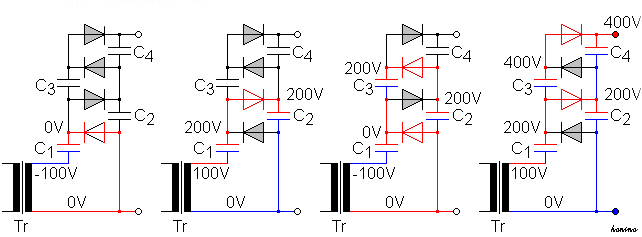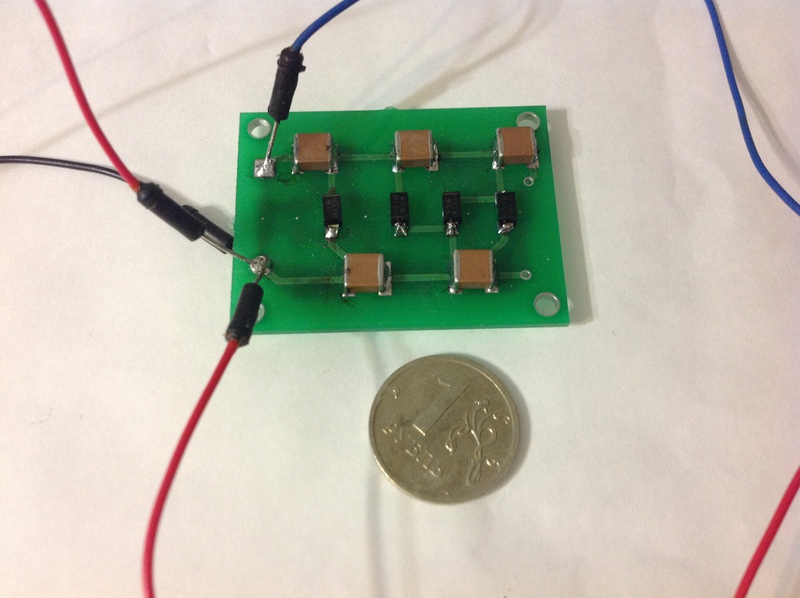Dangerous entertainment: Cockroft-Walton simple high voltage generator

Good afternoon, dear habrovchane.
This post will be small and not very educational, but it may be that someone seems interesting. In it, I will tell you how to make a very small, fully SMD-coy and easily scalable Cockroft-Walton generator , or simply a voltage multiplier that receives N volts at the input, and produces x * N volts at the output, where x is the number steps.
')
I warn you: since there are capacitors at the output (in fact, as well as at the input, there is nothing but capacitors and diodes in it), the current shock will most likely be fatal for you . Collect the scheme at your own risk and risk only if you understand what you are doing. I do not bear any responsibility for your life, health and psyche.
Not scared? Then we go further.
Background and background
Actually, the prehistory is very simple - this high voltage generator is one of the simplest circuit design, it does not contain huge coils, unlike the Tesla Transformer, and is very easy to assemble. The results, of course, are also less impressive than those of Tesla - at the output we have not a high high-frequency voltage, but simply a high voltage. Therefore, firstly, beautiful corona discharges can not be expected, and secondly, unlike Tesla, the discharge of the Cockroft-Walton generator is devoid of the skin effect, therefore, it is most likely fatal. Great care should be taken.
In general, I once collected a multiplier for myself according to the traditional scheme (we will consider a bit later) from large capacitors and diodes, which looked like this:

It had 15 stages, 400V x 0.1 µF capacitors and 1000V x 1A diodes. In order to power it, I assembled a small inverter from a 220V-> 6V transformer lying at hand, which, judging by the spark, gave out more kilovolts at the output, because of which diodes were constantly flying out (capacitors turned out to be more enduring, but occasionally died and they).
The spark at the exit was about 5 mm, it easily punched the paper and sounded like a shot from a pistol with pistons (I think many had such a thing in childhood ...).
To achieve more impressive results, it was necessary to increase the number of stages, which, with this design, I did not want to do at all - the sausage made from condensers was too big. In general, having fun with punching pieces of paper, I threw my multiplier.
But after a couple of years I saw condensers in my smd.ru store that were amazing, in my opinion. Those who work with such people every day as my friend Aregus , of course, were not new. But for me, an SMD capacitor rated for 1000V and 0.1 microfarads, after a hefty 400V conder from my old multiplier, seemed like a miracle. Therefore, I could not resist and spread a small multiplier card.
If you watch a video on youtube at the request of the Cockcroft – Walton generator , you can find, of course, much more spectacular results with a multi-kilovolt output. However, all of them are assembled on hefty condensers for mounting into holes and, more often than not, they hang in the same way in the air, like my first generator. I diluted my fee so that it was:
1) small size
2) Fully SMD
3) easily scalable.
The result was a board with a size of 35x45 mm, with fasteners in the corners of a standard rack. There are 10 stages on the board, the maximum input voltage is up to 500V. The board sustains more, but then the diodes periodically die. If we take the air breakdown voltage of 30 kV / cm, then the maximum that it gave out was several discharges at 10-15 kV, after which one of the diodes was knocked out. When operating in the nominal mode, this, of course, does not happen - it can be powered, for example, from 220V, receiving about 3111V output without detriment to its components. And, most importantly, you can easily make a dozen of such cards, make a tower of them, using racks, and get a multiplier 100 times.
Consider the circuit board.
Iron
The circuit board is very simple.

This is a typical scheme of the Cockroft-Walton generator, a voltage multiplier, which is well described in Wikipedia.
Also there is described the mechanism of his work:

Thanks to the diodes, the capacitors in turn are charged to double the supply voltage, respectively, at the output we have a voltage that has increased N times, where N is the number of capacitors in the circuit. Of course, capacitors should be selected so that they withstand this most double voltage, therefore, since The capacitors in the circuit are rated for 1000V, the maximum that can be supplied to them without fear of failure is 500V. For even account, I took 10 steps.
Next, I spread a fee:

Upper side

down side
It was possible, in principle, to reduce the size even more, but I decided not to make it shallow, so that by chance I wouldn't break through where it was not necessary.
The tracks were specially made thicker, because lack of space due to the preceding paragraph is not experienced. In general, it is easy to make a board with LUT or a photoresistive method at home.
But since I still needed to order several boards for work, I placed three multiplier modules on the same blank, since they took almost no space.
results
As a result, with the production I came here such a wonderful fee:

In the already mentioned store I bought 10 capacitors and 10 diodes (in fact, a little more, with a margin, and for good reason - I still could not resist and powered the multiplier from my inverter, the output voltage of which is clearly higher than the capacitor and diodes, as a result of which I knocked out the input diode in three or four digits).

After assembly, we get this module:

He is surrounded by my old inverter depicted in the very first photo of the article.
I did not dare to connect it to 220 volts for a long time - apparently, the effect was that I was a digital camera and never a high-voltage circuit.
I really didn’t want to shoot myself from a generator that I assembled myself on the day of my 25th birthday. But in the end, I still overpowered myself and energized the module from the outlet, connecting in series with the kettle, which acted as current-limiting resistance - with a kettle's power of 1 kW the maximum current that would flow, in the case of a short circuit in the circuit would be no more than 4.5 BUT.
Fortunately, the scheme earned the first time because of its simplicity.
Below is a video of the work. Unfortunately, my camera can not capture the normally short, but bright discharges and normally capture the accompanying sound. But, if you look in HD, you can clearly see how the digits pierce through the paper.
For those who do not want for the sake of this to watch the video in HD - photo punched paper (punched many times in the upper right corner):

By the way, the video is probably unnoticeable, but it is clearly seen live that when a piece of paper is inserted between the electrodes, the spark acquires a reddish tint - apparently due to the burning substance.
In general, capacitors and diodes cost me 200-300 rubles (15 pieces each and that), I don’t remember exactly now, but they don’t write the price on the website.
The production of the board cost me 2600 rubles in Moscow Rezonite . But it should be remembered that, first, there were six boards in the order, only three of which are multiplier cards. The total size of the workpiece was about 100x200 mm.
And secondly, from these 2600 rubles, 1800 cost preparation for production and 350 - delivery, so the boards themselves came out very cheap. I think there are a lot of dissenters, but at this price for the boards, my hand simply does not rise to fiddle with making them at home - now I prefer to work to the maximum on dummies, save up several different boards, and then order them all at once.
Future plans are to add a dozen of such cards and build a tower for 30+ kilovolts.
At this I have everything, take care of yourself and be careful with high voltage.
Source: https://habr.com/ru/post/175207/
All Articles